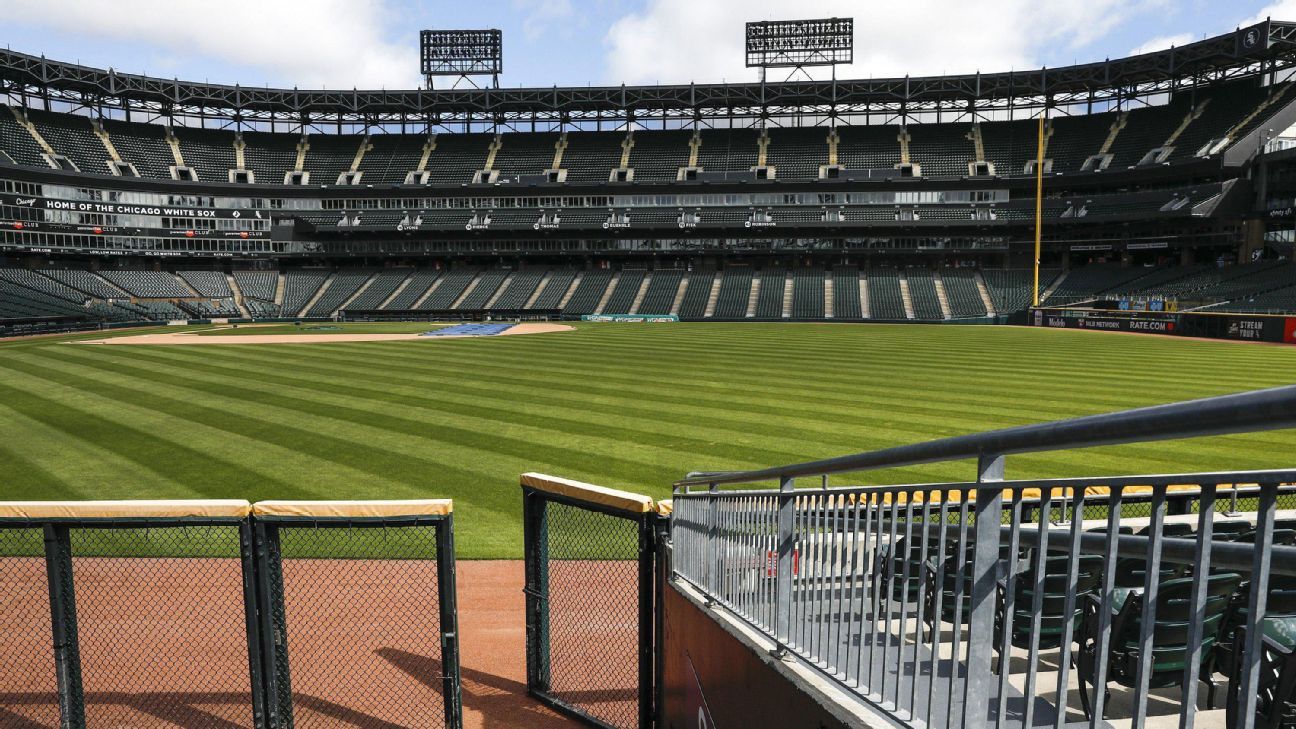Major League Baseball owners voted unanimously to proceed with the 2020 MLB season under the terms of their March 26 agreement with the MLB Players Association, the league said in a statement Monday night, after the union’s executive board voted down MLB’s latest offer of a 60-game season with expanded playoffs.
While the deal still has hurdles to clear before spring training 2.0 can begin, this is the biggest step yet toward answering the question of when Opening Day will be played in major league stadiums across North America. ESPN MLB reporters Bradford Doolittle, Jesse Rogers and Alden Gonzalez break down everything you need to know about the schedule announcement, the likelihood it actually leads to baseball being played soon and what the games could look like when they begin.
2020 season quick facts:
Number of games: Likely 60 games
Opening Day: Late July — Perhaps July 21 if they maintain the previous balance of days off to scheduled games during the regular season.
Spring Training: July 1 — MLB asked the MLBPA on Monday whether players will be able to report to training in their respective cities within seven days, by July 1.
Number of teams in playoffs: 10
Salary structure: Full pro rata, which for 60 games means that players will earn around 37% of their full-season salary as long as the truncated schedule is completed
Frequently asked questions
What makes a 60-game season work, and what will the biggest challenges be?
The biggest challenges revolve around the health of the players — that includes coronavirus concerns as well as normal baseball injuries. An oblique injury could keep a player out for 4-8 weeks, or longer — that’s nearly the entire season. Will guys push themselves to get back early or be extra cautious while thinking of their future? Both may be true as every player will come at the shortened season with a different perspective. The good news is veteran pitchers, especially starters, won’t have to hold anything back for the stretch run — the stretch run starts right away. If guys are in shape, we should see the best of what they have.
What’s next now that a season schedule is being implemented?
Spring training 2.0. That will start in about a week (the commissioner has asked about July 1) as players will need to travel to their home cities if they aren’t in them already. Some will need to find housing — undoubtedly on short leases — so a lot has to happen in a short period of time. Roster sizes, taxi squads and new on-field rules for 2020 all have to come together — and fast.
Does the commissioner taking these steps 100% mean there will be a 2020 MLB season?
Unless the players go on strike — which is extremely unlikely — then, yes, we will have a season.
How might a grievance from the MLBPA affect the 2020 season?
It shouldn’t have any effect, as these things take a long time to resolve. We’re talking years, which overlaps with the looming talks for the CBA.
What will the playoffs look like under this format?
With the end result of all these futile talks being a Manfred-implemented season, we end up with the same playoff format as we’ve had since the two-wild-card system was adopted for the 2012 season. One of the things the union denied by adhering to the terms of the March 26 agreement was the owners’ wish for an expanded playoff format.
Suffice to say, a mini-season combined with a play-in game and a bracket that might be full of mediocre teams is not the ideal outcome. With a 16-team bracket, at least the unwieldy field would have improved the likelihood of baseball’s best teams advancing to October. Of course, those teams could still have been knocked out by a sub-.500 team in a short series. Any way you slice it, if you precede any kind of baseball playoff format with a mini-season, there isn’t much competitive integrity to the proceedings.
What about other big on-the-field changes?
MLB and the union previously agreed to adopt the minor league rule for extra innings, beginning every half-inning after the ninth with a runner on second base, according to a report from USA Today. The rule is set for only the regular season and — for now, at least — only for 2020. The designated runner would be the person who made the final out in the prior half-inning. The pitcher would not be charged with an earned run if that runner crosses home plate; it would be scored as if that runner reached via error, according to USA Today.
When would spring training start and where will teams train?
The commissioner has asked the union if it can determine if all players can report by July 1. After a spate of positive COVID-19 tests late last week, Manfred shut down spring training facilities in Arizona and Florida. Now teams will retreat to their home cities to conduct a rapid and uncertain second spring training, or early summer training to be more precise. Roughly three weeks is expected to be the duration of the ramp-up period.
What is still to be clarified: What about the teams (Marlins, Rays, Diamondbacks) actually based in Florida and Arizona? What about other teams in states with spiking numbers, like Texas? And what about the Toronto Blue Jays? Last week, Canadian Prime Minister Justin Trudeau announced that the border shutdown between the U.S. and Canada would be extended to July 21, and there is no guarantee that it won’t be extended beyond that date. For the time being, the Blue Jays can’t train at their facility in Florida. Their Triple-A affiliate (Buffalo, N.Y.) isn’t that far from Toronto, so that may be the answer.
What about the recent spike in coronavirus cases and positive tests from MLB players?
With numbers spiking in about half the states across the country, according to news reports on Monday, the only tangible change in recent days was MLB’s decision to shut down all spring training complexes in Florida and Arizona. Teams will now train in their home cities, while scrambling to put a more formal and universal system of protocols in place.
The larger problem is not specific to baseball: What happens if the numbers return to a pattern of exponential spread? For now, baseball and the other sports have to proceed as if they are going to be able to play in a newly-reopened country. However, the specter of the pandemic rendering all of these plans moot hangs over the sports world like the sword of Damocles. With a number of positive tests coming to light in the baseball-verse the last few days, it’s clear that MLB and the MLBPA will be battling the pandemic as much as they have battled each other the last few months.
What do we know about the health-and-safety protocol now?
We’ll find out what changes have been made to MLB’s original 67-page pitch if the players sign off on the policy over the next day or two. Among the key points of that initial plan:
• Players and other team personnel not participating in the game would sit in the stands, separated by at least six feet. They would apply the same distancing standards to the national anthem.
• Celebratory contact is verboten: No high-fives, fist bumps or hugs.
• The grand tradition of gross habits is on hiatus: No spitting, chewing of tobacco or sunflower seeds or any combination thereof.
• A minimal distance between baserunners, fielders, coaches and umpires on the field will be encouraged as much as possible.
• A ball will be thrown out once it’s been touched by multiple players.
• Postgame showers are discouraged, as will be the use of taxis and rideshares.
• Players will be screened for temperature multiple times per day and tested for coronavirus multiple times per week. Anyone testing positive will be immediately quarantined. Two negative tests will be required for a possible return.

